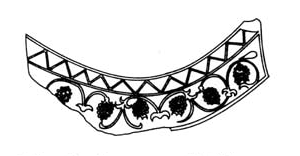| Also
abbreviated to *budou karakusa
¸. A grape-patterned arabesque used on the pendant *gatou
˘, of a broad concave eave end tile *nokihiragawara
Ź˝˘. Tiles with this motif are found on buildings at Okadera Ş in Nara and its
vicinity. The grapevine motif is found in ancient Greece, Rome, and the Near East.
It reached China and was first used during the Northern Wei dynasty (Jp: Hokugi
ké°) in caves at Yungang (Jp: Unkou _ź) and Lungmen (Jp: Ryuumon ´ĺ).
During the Sui and Tang dynasties, it was widely used
at Chang-an (Jp: Chouan ˇŔ). In Korea it was used as a tile pattern during the
Unified Silla period (Jp: Touitsu Shiragi ęV
). Tiles with a grapevine
motif can be dated to the late 7c. There are four slightly different renderings
of the pattern: three found at Okadera and one at Jikouji ő ruins, both in Nara. Across the upper face of each tile, there is a zigzag motif *kyoshimon
ś, *inazumamon îČś,
separated from the grapevine pattern by a high ridge. |



